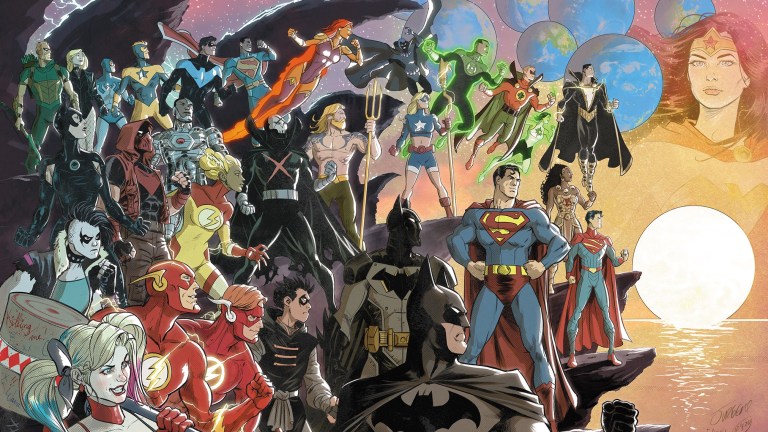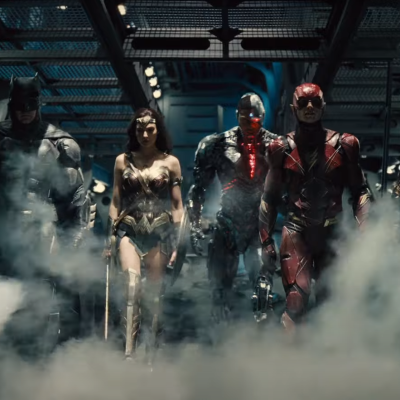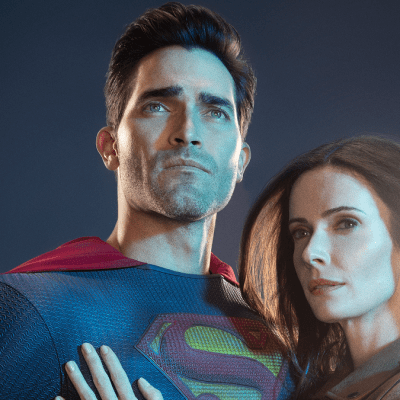Infinite Frontier and the Infinite Possibilities of the DC Universe
DC's Infinite Frontier takes a new approach to DC continuity: everything counts and it all happened. We've got the inside scoop on what the next evolution of the DC Universe means.

Joshua Williamson has had his hands in just about every big DC story for the last five years. One of the longest-tenured Flash writers ever, Williamson has by necessity been in the middle of every time the DC multiverse tried to burst back into canon over the last five years. After all, you can’t have a Crisis without a Flash beat or three.
But now, Williamson is getting the keys to the bus. Infinite Frontier #0 kicks off the post-Metal, post-Future State new status quo for the DC Universe in March. That status quo builds off of DC’s new multiversal mantra: everything happened and anything is possible. We had a chance to talk with him about what that means on both ends – what the new DCU is growing out of, and what’s coming in the future.
This interview has been lightly edited for clarity.
Den of Geek: Give me an elevator pitch Infinite Frontier coming out of Future State.
Joshua Williamson: What we’re doing is we’re taking all of these things that we love about the DCU and everything that happened through Death Metal and everything that’s happening with Future State. And we’re just taking everything that we love with the DCU. We’re just moving it forward, with the Infinite Frontier Special, Wonder Woman and The Spectre go on this journey where they explore this new DCU [and what] the DCU looks like after things like Death Metal and Future State. One of the themes of Infinite Frontier is anything is possible.
You’re getting to play with all the toys now. What are your touchstone DC runs? When you think about the DC multiverse and all of the enormous, insane glory, what are the first stories that you think of? What are the trades that you give to people?
Oh man, that’s a tough question. I feel like I would definitely give them Grant [Morrison]’s JLA, I think the stuff that they did on that series was really powerful. And especially once you get to “Rock of Ages” or Mark Waid’s “Tower of Babel” from that same era. [Morrison and Howard Porter’s] JLA #1 is a really important comic for the DC Universe. I think it’s a moment where things started to turn a little into a new era.
I definitely would give people Mark Waid’s Flash stuff. I think you can’t go wrong with Dark Knight Returns or Batman: Year One. [Darwyn Cooke’s] New Frontier is one of the best examples of what DC can be….I think you could also give them Long Halloween. There’s so much stuff you can give them.
I’m always partial to giving things like Knightfall, Death of Superman, just because of how old I am, I think. Those stories were so big when I was coming into the DCU. Kingdom Come is really good and obviously, you get around to things like Crisis on Infinite Earths and Infinite Crisis. I think that build up to Infinite Crisis, when you get to Countdown To Infinite Crisis, plus all the minis and 52 that’s one of my favorite eras of DC, is that block of time.
That Death & Return of Superman era was nuts with how many talented creators were working at the top of their games.
And they were doing that triangle number thing where Superman was a weekly book for a long time and all that stuff was really strong. I still think about that stuff. I actually got to work with Dan Jurgens recently on a few different things. I was originally one of the creators working on Generations. And…he did the cover for Infinite Frontier #0.
So when he was working on that cover, I sent him a bunch of different ideas of what I was looking for and thinking a lot about. We were talking a lot about New Frontier and…the positivity and the fun of DC…and it’s like, well, this is the next step of the DCU, right? We’re definitely moving forward. It’s a new era in many different ways and so we wanted to find ways of showcasing that. There are new characters, so there’s new characters on that cover. Dan had questions about them and he was texting me and then he just called me and we started just talking about Infinite Frontier and history stuff about DC and his time working on Justice League and his time doing Superman.
And in the back of his office, he has a piece of art from Reign of the Supermen from the later issues. I think it’s Superman #81, it might be a little bit later, but you know that one that has the green floral cover and it has Superman in the black costume, he’s charging forward [editor’s note: it is Superman #81 and Williamson pulled this from memory]. He has that in his office. It’s so cool to see it, and just to be able to talk to him about it.
When it comes to DC there’s so many different great eras. I look at it as these big blocks. You can break them up by decades. I think part of the motivation behind Infinite Frontier is we saw an opportunity to draw a line in the sand and be like, this is the new era. This is the step moving forward and everything before this mattered, everything counted, all those things you love happened and mattered. So now we want to be able to move forward and just take all that stuff, take all those things we love, all those stories we love and say they happened and now let’s go, let’s get the ground running and go with it.
I’m a continuity junkie. And sometimes I’ve had editors call me out and they’ll be like, “Why are you referencing? What is this you’re referencing?” And I’m like, “Oh, that’s from this comic book from 1997.” And they’re like, “Oh, well, did that happen? Did that happen?” This would come up sometimes during Rebirth where they’ll be like, “Well, did that happen post Flashpoint?” And I’m like, “It did now. Let’s figure out how to make it work.” I think that’s part of the approach now. I think there’s a freedom to reference what you want.
But at the same time, it can’t be all about all these things that happened in the past and just trying to relive it or try to re-glorify it or whatever, you have to tell new stuff. I think one of the most exciting parts about Future State has been seeing its progress, seeing where it started and where it is now, but seeing the response to it. It was really awesome to watch how people are excited about new characters, new looks, new stories, just new stuff. I think right now the DCU is becoming an unpredictable place…not just in terms of the characters, but I think in terms of readers, I think there’s things that you’re going to see that you’re you’re going to be surprised by.
Don’t get me wrong, we’re definitely going to reference the past. I think if somebody is reading Infinite Frontier or the other books that I’m working on for DC in the next year, I’m definitely going to pull things from the past, especially things that I think we’re still missing that I want to bring back in. But that all being said, it’s taking those things and saying, “Okay, how do I tell a new story with it? how do I move those things forward?”
Future State Justice League is explicitly about legacy heroes in a way that the DC Universe hasn’t really been since the mid 2000s…I assume that we can take that as a hint about what’s to come from you from Infinite Frontier and from your future in the DCU.
When I started reading comics as a kid, I was a casual reader. But when I was able to get on my bike and ride to the comic store and grab the books, the DCU was a different place. I started reading Green Lantern at issue 45 because it crossed over to Superman. 46 is a Green Lantern/Green Arrow crossover and then those issues, like 48, 49 and 50 are Emerald Twilight with Hal going crazy and then issue 51, introduces Kyle Rayner.
So you have Kyle Rayner as Green Lantern and Wally West as Flash and Bart Allen was introduced and there’s a new Robin with Tim Drake and Jean-Paul Valley was Batman for a hot second. And there were four Supermen. All of these big changes, all these new elements were introduced.
I think for readers, it’s important to introduce those new things, because then you can take ownership over it. [As a reader]I have a Green Lantern that was introduced and I got to see the world of Green Lantern through his eyes..
You use that new stuff as a vehicle to reintroduce all this huge mythology that’s out there. So I was very excited about that idea of introducing new things. And so that’s why when we started talking about my particular involvement with Justice League and Future State, I wanted it to be just all new characters.
Jon [Kent] was a no-brainer as Superman. I was so excited to get Jo [Mullein, the Green Lantern from one of the best GL books ever, Far Sector]. I wasn’t sure I was going to get Jo for a minute. I kept asking about it and we kept talking about it, but that was one of the ones I really wanted, was Jo and then they gave me Jo.
I’ve written a lot of Flash, so it was important to me to do a Flash I had never written before. And so they presented options to me and one of them was Jess [Chambers, the Earth-11 Flash who is part of the Future State Justice League that Williamson wrote]. And we started talking about how Jess was from the multiverse and what character they were. You can look at how Future State Justice League is and how it is very much about the new, but I’m also using elements of the past and using these classic elements or things that I personally love like the Hyperclan or little hints of things through the Hall of Justice.
And, I like teasing stuff. I love teasing things. I love putting little hints of stories to come throughout books because … When I was younger, I would reread stuff a lot. I would reread Death of Superman and there were times I would find things that I hadn’t picked up on before. If you go and you look at something like so much of Geoff Johns’ stuff in The Flash or JSA and how much he was able to take things that were older, these little seeds of story.
Grant Morrison loves to put ideas on the table that someone else can pick up. I also want to do that. [Now that] both issues of Future State Justice League are out, you can see a couple more seeds of things that are coming.
There is a moment where the Spectre and Wonder Woman, they do talk about Future State at the beginning of Infinite Frontier #0. They talk about what she saw, because she sees Future State. And so it’s this idea of what does she actually see and does all that mean it’s just coming to pass and the Spectre, he is like, “It depends.” You’ll see when we get there.
But there is a conversation about what those futures are. I think once you read Infinite Frontier #0, you’re going to see a lot of elements of things that I personally like and wanted to bring in and then there’s some stuff about moving the ball forward. I think that’s what’s really exciting about all the other chapters in Infinite Frontier, because it’s like a lot of what I’m doing is overall the structure in Infinite Frontier, trying to get these balls to move forward but also put things on the table for the next year for the DCU. There are a lot of other chapters in there that are written by other creators that really are a lot about the new, like Tim Sheridan has story about Teen Titans that’s about the new kids coming into Teen Titans Academy. You have Geoffrey Thorne and Dexter Soy doing a story about the Green Lanterns that is awesome. It’s really exciting to see some of this stuff.
I think people always want all the answers laid out on the table immediately.
When Death Metal was over, I think people really wanted us to release a spreadsheet of, well, here are the rules, this is the thing, this is what happened but I think the characters don’t even know that. They’re still figuring stuff out. That’s part of why the Totality was created at the end of Death Metal. It’s infinite possibilities and now we have to explore what this means. And that’s part of what we’re going to be doing with DCU…What does infinite possibilities in an infinite multiverse? What does that even mean? How does that impact it?
And then, at the end of Death Metal, The Presence, The Hands on the other side of the wall, they told Wonder Woman there was a cost there, there was a cost of doing what they were doing and she thought that that was her death, but it was like, no, you’re ascending. There’s something else and, if you get infinite possibilities, that sounds terrific. Right? But there’s a part where Spectre and Wonder Woman are talking about it and he’s like, “Yeah, infinite wonder.” And she’s like, “Yeah but infinite terror. That means there could be something bad out there too.” And she’s aware of this cost and she’s trying to find out what that cost is in Infinite Frontier #0, she’s trying to figure out what it was.
We’re putting all these questions on the table and we’re going to let those answers come or organically again. I think you’ll see when you get to Infinite Frontier #0, is we’re going to answer some questions. But then we’re also going to put some new ones on the table that are going to take a little bit to answer.
It’s almost more fun when you hear the writer asking the question at the same time that you are, right?
Yeah.
Like, this is something we’re supposed to be concerned about, this is something that we’ve got to watch further, right?
Yeah. We’re all in this together. Just have fun with it.
You’re working with John Timms and John Romita Jr. on the bookend chapters.
Yeah. I’m also working with Howard Porter and Alex Maleev. So I have four chapters, it’s John Timms, Alex Maleev, Howard Porter and then yeah, John Romita.
Those are four very different styles and I know you’ve worked with Porter a bunch on Flash. He’s a Flash legend, Justice League legend. But what’s it like switching gears in your head, especially in the same book, going between those four dramatically different styles, are you bringing anything back and forth between the four different artists like, “Oh, JR Jr. did this or Timms did this and it was cool as hell.” Or are you just throwing up your hands and saying, “You guys are pros, do your thing.”
No, no. I wrote for them.For Alex Maleev I was very specific about which scene I want him to do, which characters I want him to draw and so I wrote it for him, I’m a big fan of his Daredevil run with [Brian Michael] Bendis and so I wrote it for him. I very much wrote a scene that I thought would lean into him, that I knew he would excel at, with a character but I think, I just knew, like you know that guy is going to draw that character. It’s going to be cool.
Howard draws the Flash part. I definitely in the script was like, “Howard you know what’s up. I don’t have to get deep into who these characters are, you know what’s going on.” But it’s a big moment for the Flash family and I wanted Howard to be the one to draw it and he was very excited about that and he totally knocked it out of the park.
John Timms and I have talked about working with each other for years. We knew each other back when he had just started working at DC, on Harley Quinn, we were talking. So I’ve known him and I’ve seen him grow as this artist and I think that the stuff he’s doing on Infinite Frontier is his best work to date. It looks amazing and he draws some of the bigger moments in the issue. There’s some really cool, big stuff that he does in it.
And then with John Romita Jr. I mean, come on that dude is a legend. I mean, that guy, he and I have had conversations over the last five years and he’s definitely been on the bucket list of creators I wanted to work with and so he became the option. I was like, “Oh, he has to do the epilogue.” And what was crazy, I found out as we were getting it ready and I was writing the script for him. One of the big characters that’s in the epilogue, he had never drawn before and I was surprised by that. I couldn’t find it anywhere. And so he actually called me when he was working on it so we could talk out some stuff on it, but I wrote it for him. I knew what he wants as an artist, what he looks for, when he was doing Daredevil: Man Without Fear [with Frank Miller], that was a five page script and he turned it into six issues.
He is a legend and he’s a great story teller. For him, I wrote it in a style that I knew he liked. And when those pages came in, he really nails it and he gets what we wanted from that ending.
It was awesome working with all these different artists [with] everything else coming through. It was just so great. Jorge Jimenez did the Batman pages with James [Tynion IV]. Those are so cool. And then, James also did a story about Alan Scott, he did the Alan Scott chapter and that was drawn by Stephen Byrne and every time the pages came in, you were just like, “Oh this is so cool.” A lot of it looks really good. Bendis’ pages [with David] Marquez look really great.
Todd Nauck is a friend of mine and I really liked when he was doing Young Justice back in the day. He hasn’t really worked at DC in a long time and so he comes in doing this four-pager with Geoff Johns for Stargirl and it just looks so cool. It’s an interesting book full of a lot of really creative, talented people and I’m excited to share it with people.
Now that everything counts again, what piece of continuity are you most excited to put back into the puzzle?
Oh, I can’t tell you that. [laughs] There’s a bunch. I’m sneaking them all in.
Everything? Is there a piece of continuity that you thought of initially and you said, “No, I can’t possibly do that.”
Not yet. Everything could be used as a tool. I mean, listen, there are elements of stories that I personally would not be a fan of that I might not go for but that isn’t to say that they are bad. There’s just not things that I’m personally interested in, but there’s so much stuff that I am interested in, that’s where I focus. All of the stuff that I want to bring in, characters that are missing, things like that, that haven’t been used in a while. I am a greedy person when it comes to that, I am trying to grab all of them and it’s important to me to bring all this cool stuff back in. Yeah.
Now I know [an ongoing Robin series with art by Gleb Melinkov] is what’s immediately next coming out of this but is there something else coming out of Infinite Frontier #0, in the DC Universe that you can share yet? Or not yet?
Not yet. I think once Infinite Frontier #0 comes out, it’ll be really obvious.
Infinite Frontier #0 hits on March 2.


